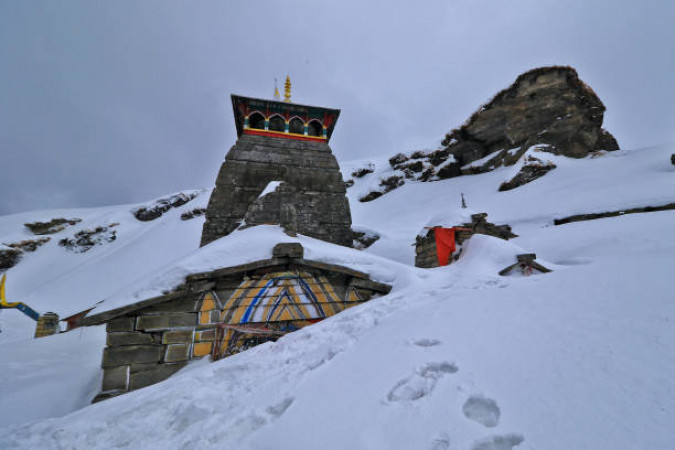
Tungnath
Duration
2 to 4 Days
2 to 4 Days
Best time to visit
May-Jun, Sep-Oct
May-Jun, Sep-Oct
Theme
Hill Station, Religious
Hill Station, Religious
Tungnath Travel Guide
Tungnath, located in the Indian state of Uttarakhand, is renowned for being the highest Shiva temple in the world. Nestled in the Garhwal Himalayas at an altitude of 3,680 meters, Tungnath is not only a sacred pilgrimage site but also a trekker's paradise. The region is steeped in mythology and offers breathtaking views of the surrounding peaks, making it a must-visit destination for spiritual seekers and nature lovers alike.Top Attractions in Tungnath
- Tungnath Temple
- Chandrashila Peak
- Deoria Tal
- Chopta
- Kanchula Korak Musk Deer Sanctuary
Tungnath is Famous for
Being the highest Shiva temple in the world.Top Attractions in Tungnath
- Experience the serene beauty of Tungnath Temple
- Trek to the breathtaking Chandrashila Peak
- Visit the pristine Deoria Tal lake
- Explore the picturesque village of Chopta
- Spot rare wildlife at Kanchula Korak Musk Deer Sanctuary
What's Great about Travelling to Tungnath?
- Perfect for spiritual seekers
- Offers stunning views of the Himalayas
- Great trekking opportunities
- Peaceful and serene atmosphere
What's Not So Great about Travelling to Tungnath?
- High altitude may pose challenges for some travelers
- Limited accommodation options
- Remote location with limited amenities
- Weather can be unpredictable
Travel Tips for Tungnath
- Ensure proper acclimatization due to high altitude
- Carry sufficient warm clothing and trekking gear
- Respect the local customs and traditions
- Be prepared for basic facilities in the region
Important Tungnath trip information
- Ideal Duration: 2-3 days
- Best Time to Visit: May to June and September to October
- Nearby Airports and Railway Stations: The nearest airport is Jolly Grant Airport in Dehradun, and the nearest railway station is Haridwar.
Top 5 Places to visit in Tungnath
FAQ's on Tungnath
Q1: What is the best time to visit Tungnath?
The best time to visit Tungnath is during the summer months from April to June when the weather is pleasant and ideal for trekking. Another good time is in the autumn months of September to November when the skies are clear, offering stunning views of the Himalayas. It's best to avoid the monsoon season from July to August due to heavy rainfall which can make trekking difficult.
Q2: Do I need a visa to travel to Tungnath?
As Tungnath is located in India, tourists will need a valid Indian visa to travel here. Visitors should check the specific visa requirements based on their nationality. Some nationalities may be eligible for e-visas or visa on arrival, but it's important to check the latest regulations before planning your trip.
Q3: What are the must-visit attractions in Tungnath?
Tungnath is famous for its ancient Tungnath Temple, one of the Panch Kedar temples dedicated to Lord Shiva. Visitors can also trek to Chandrashila Peak for breathtaking views of the Himalayas. Other attractions include Deoria Tal, a pristine lake surrounded by lush forests, and Rohini Bugyal, a picturesque meadow offering a serene setting for nature lovers.
Q4: Is Tungnath a safe place to travel?
Tungnath is generally a safe destination for travelers. However, it's essential to take standard precautions such as securing your belongings and being aware of your surroundings, especially while trekking in remote areas. It's advisable to check weather conditions and trekking routes before embarking on any outdoor activities.
Q5: What is the local currency in Tungnath and can I use credit cards?
The local currency in Tungnath is the Indian Rupee (INR). While credit cards may be accepted in some hotels and larger establishments, it's recommended to carry cash for smaller purchases and in remote areas. ATMs are limited, so it's advisable to withdraw sufficient cash before traveling to Tungnath.
Q6: What is the local cuisine like in Tungnath?
Tungnath offers a variety of local cuisine with influences from North Indian flavors. Popular dishes include Rajma Chawal (kidney beans with rice), Aloo Puri (potato curry with fried bread), and Kheer (rice pudding). For those trekking, local tea stalls offer hot beverages and snacks. Travelers with dietary restrictions can find vegetarian and vegan options readily available.
Q7: What transportation options are available in Tungnath?
In Tungnath, transportation options include local buses, taxis, and shared jeeps for getting around. Trekking is a common way to explore the area, especially to reach the Tungnath Temple and nearby attractions. It's recommended to hire a local guide for treks to ensure a safe and enjoyable experience. Private car rentals are also available for those who prefer more flexibility in their travel.
Q8: Are there any cultural norms or etiquette I should be aware of when visiting Tungnath?
When visiting Tungnath, it's important to respect local customs and traditions. Dress modestly, especially when visiting religious sites like the Tungnath Temple. Remove your shoes before entering temples and other sacred places. Avoid public displays of affection, and always ask for permission before taking photographs of locals. Greet people with a polite "Namaste" and be open to experiencing the local culture with respect and curiosity.
Q9: I am a travel agent. How can I buy travel leads of Tungnath?
Register yourself as a travel agent at agents.tripclap.com and then you can buy travel leads to Tungnath once your account is approved. For more details contact our support team at +91-8069186564 or support@tripclap.com
